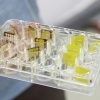The reproduction number, or R value, of coronavirus has fallen below one for the first time since July and is estimated to be between 0.7 and 0.9 across the UK.
In a sign that lockdown restrictions may be having an impact and the epidemic is shrinking, scientists advising the government gave their most optimistic outlook for the R number since cases fell last summer.
The estimates for R and the growth rate are provided by the Scientific Advisory Group for Emergencies (Sage). The growth rate, which estimates how quickly the number of infections is changing day by day, is between -5% and -2% for the UK as a whole.
It means the number of new infections is shrinking by 2-5% every day. Sage said the estimates are based on the latest data, available up to 8 February, including hospital admissions and deaths, as well as symptomatic testing and prevalence studies.
It said the estimates of the R value are below 1 in all NHS regions of England, but warned: “However, prevalence of the virus remains high, so it remains important that everyone continues to stay at home in order to keep the R value down, protect the NHS and help save lives.”
The latest data from the Office for National Statistics (ONS) suggests that about one in 80 people in England had the disease in the week ending 6 February, compared with one in 85 in Wales, one in 75 in Northern Ireland and one in 150 in Scotland. The week before the figures were one in 65, one in 70, one in 65 and one in 115 respectively.
UK cases
In England, Wales and Northern Ireland, declines were seen in the percentage of cases thought to be associated with new and older variants. However, within Scotland, the percentage of people testing positive with what looked like the B117 variant had levelled off.
Within England, the percentage of people testing positive has decreased in all regions except for the south-west, where the rate appears to have levelled off – although it remains lower than in most other English regions, and some areas of the south-west have the lowest rates of all. Caution should also be taken in over-interpreting any small movements in the latest trend, the report said.
London had the highest percentage of people testing positive, estimated at 1.6% on 6 February, but pockets of the West Midlands, the east of England and the north-west also had high rates.
Although the ONS data suggests lockdown is continuing to reduce community infection rates, the drop is not as pronounced as the fall in cases reported from pillar I and II diagnostic tests. These are largely done on people with coronavirus symptoms, whereas the ONS survey data is based on tests of randomly selected households.
Experts have previously suggested that this disparity could be due to changes in testing behaviour, or the growing use of less accurate lateral flow tests in pillar II (community) testing.




















































Свежие комментарии